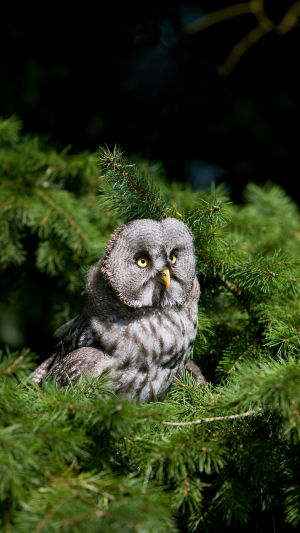There are more than 130 species of owls. It is found on all continents except Antarctica. Owls like to hide among the leaves to sleep during the day and wait until nightfall to forage.
The head is broad, the mouth is short and thick, and the front end is hooked. The feathers on the front of the head are arranged in a face plate, and some species have ear-like feathers. The head is very similar to that of a cat, so it is commonly known as an owl.
Share interesting facts about owls.
1. The hearing of owls is very good, and owls can turn their heads almost completely, up to 270 degrees.
2. The lifespan of an owl is about 20 years. Its eggs do not hatch at the same time.
3. The size of the owl depends on the species, owls don't chew food because they don't have teeth.
4. Owls have three eyelids: one for blinking, one for sleeping, and one for keeping their eyes healthy and clean.
5. Owls are solitary animals. Compared to other animals, owls are very quiet in flight. Their eyes are very sensitive, but they cannot move.
6. Owls can be found on every continent except Antarctica. The color of owl feathers helps them blend into the environment for camouflage.
7. Owls' eyes are not really "eyeballs", their tubular eyes are completely motionless, providing binocular vision, fully paying attention to prey, and improving depth perception.
Habits of owls.
Habitat.
Most owls perch in trees, some species inhabit rocks and grass.
Living habit.
The vast majority of owls are nocturnal animals, and they are nocturnal, and they are not easy to be seen when they hide in the woods or under the eaves of trees during the day.
Food.
Mainly rodents, but also eat insects, birds, lizards, fish and other animals. Food is often swallowed whole, and the indigestible bones, feathers, hair, chitin and other residues in the food are aggregated into small groups, which are spit out through the esophagus and mouth, called food pills.
Colorblind.
Owls are colorblind and the only birds that cannot distinguish colors.
Prey.
Once the owl has located its prey, it will strike quickly. It can continuously adjust the direction of the attack according to the noise generated by the movement of the prey, and finally succeed in preying.
The Eurasian eagle is the largest owl in the world, with an average length of 66-71 cm and a weight of 4 kg.
But don't be deceived by its appearance!





